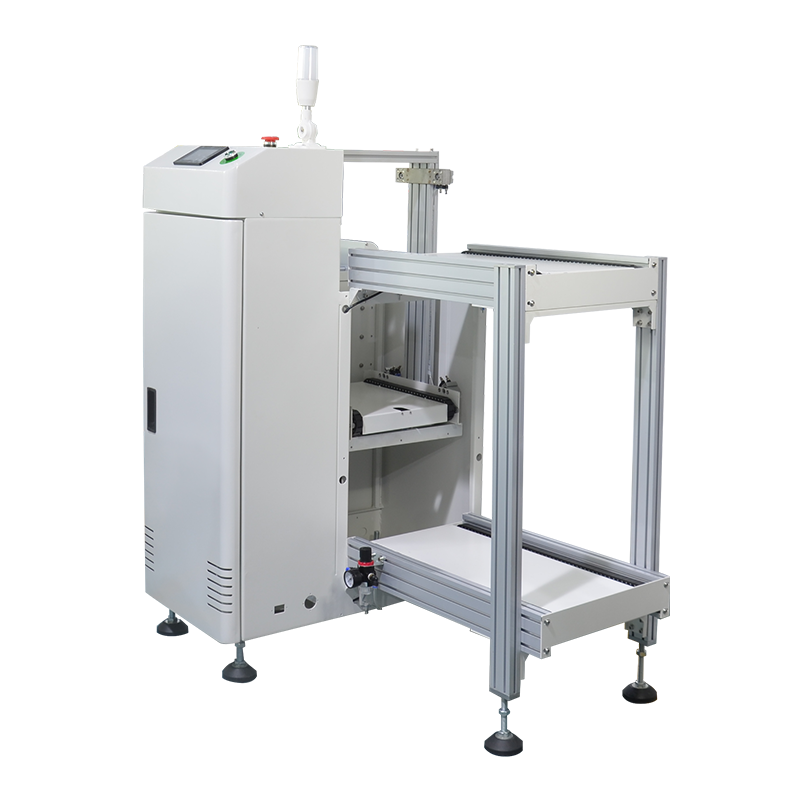Email format error
Email cannot be empty
Email already exists
6-20 characters(letters plus numbers only)
The password is inconsistent
Email format error
Email cannot be empty
Email does not exist
6-20 characters(letters plus numbers only)
The password is inconsistent


Maximizing Efficiency with the SMD PCB Loader Set: A Comprehensive Guide
In the fast-paced world of electronics manufacturing, efficiency is key. One essential tool that can significantly streamline the production process is the SMD PCB loader set. This comprehensive guide will explore the various aspects of this critical equipment, its benefits, and how it can transform your manufacturing workflow.
What is an SMD PCB Loader Set?
An SMD PCB loader set is a specialized piece of machinery designed to automate the loading and unloading of printed circuit boards (PCBs) in surface-mount technology (SMT) assembly lines. These loaders ensure that PCBs are correctly positioned and ready for subsequent processes, such as soldering and component placement.
Key Components of an SMD PCB Loader Set
An SMD PCB loader set typically comprises several components, each playing a crucial role in the loading process:
1. Magazine Rack: Holds multiple PCBs in a stacked configuration.
2. Conveyor System: Transports PCBs from the magazine rack to the next stage in the assembly line.
3. Lifting Mechanism: Moves PCBs from the magazine to the conveyor.
4. Control Unit: Manages the operations of the loader set, ensuring precision and synchronization with other equipment.
Advantages of Using an SMD PCB Loader Set
Increased Productivity
The automation provided by an SMD PCB loader set significantly reduces the time required for manual loading and unloading of PCBs. This increase in efficiency leads to higher throughput and the ability to meet tighter production schedules.
Enhanced Precision and Consistency
Manual handling of PCBs can introduce variability and errors. An SMD PCB loader set ensures each PCB is loaded with precision, maintaining consistent quality across all units. This consistency is particularly important for high-volume production runs.
Reduced Labor Costs
By automating the loading process, the need for manual labor is decreased. This reduction in labor not only cuts costs but also minimizes the risk of human error, further enhancing the overall efficiency of the production line.
Improved Safety
Handling PCBs manually can pose safety risks, especially in high-speed production environments. The PCB loader set mitigates these risks by automating the process, creating a safer workplace for operators.
How to Choose the Right SMD PCB Loader Set
Selecting the appropriate SMD PCB loader set for your manufacturing needs requires careful consideration of several factors:
Production Volume
The capacity should align with your production volume. High-volume manufacturers will benefit from loaders with larger magazine capacities and faster loading speeds.
PCB Size and Thickness
Ensure that the loader set can accommodate the size and thickness of your PCBs. Some loaders offer adjustable settings to handle a range of PCB dimensions.
Integration with Existing Equipment
The PCB loader set should seamlessly integrate with your existing SMT equipment. Compatibility with your conveyor systems and pick-and-place machines is crucial for a smooth workflow.
Budget
While investing in the PCB loader set can yield long-term savings, it's important to choose a model that fits within your budget. Consider the total cost of ownership, including maintenance and potential upgrades.
Installing and Setting Up Your SMD PCB Loader Set
Proper installation and setup are vital to maximizing the benefits. Follow these steps to ensure a smooth implementation:
Site Preparation
Choose a location that allows for easy integration with your existing SMT line. Ensure that there is adequate space for the loader set and that the area is free from obstructions.
Electrical and Connectivity Setup
Connect the loader set to a reliable power source and ensure that all control and communication cables are properly connected. This setup is crucial for synchronization with other equipment in the assembly line.
Calibration and Testing
Calibrate the loader set according to the manufacturer's instructions. Perform initial testing with sample PCBs to verify that the loader functions correctly and aligns with your production requirements.
Training and Documentation
Provide training for operators and maintenance personnel on the proper use and upkeep of the loader set. Maintain comprehensive documentation for reference during troubleshooting and routine maintenance.
Optimizing Your Production Line with an SMD PCB Loader Set
Once your SMD PCB loader set is operational, there are several strategies you can employ to optimize its performance and further enhance your production line efficiency:
Regular Maintenance
Implement a routine maintenance schedule to keep the loader set in optimal condition. Regularly inspect components for wear and tear, and replace any parts as needed to prevent downtime.
Continuous Monitoring
Utilize monitoring systems to track the performance of the loader set in real-time. Identify and address any issues promptly to avoid disruptions in the production process.
Process Optimization
Analyze the workflow and identify opportunities to streamline processes. For example, adjusting the speed of the conveyor system or optimizing the sequence of operations can lead to further efficiency gains.
Case Study: Success with an LED SMD PCB Loader
To illustrate the impact of an SMD PCB loader set, let's examine a case study involving an LED manufacturer.
Background
A leading LED manufacturer sought to increase production capacity and improve quality consistency. The manual loading of PCBs was a bottleneck, leading to delays and variability in the assembly process.
Solution
The manufacturer invested in the SMD PCB loader, specifically designed to handle the unique requirements of LED PCBs. This loader was integrated into their existing SMT line, replacing manual loading processes.
Results
The implementation of the LED SMD PCB loader yielded impressive results:
- Increased Production Speed: The automated loader significantly reduced loading times, allowing the manufacturer to meet growing demand.
- Improved Quality: The precision of the loader ensured that each PCB was consistently positioned, reducing defects and rework.
- Cost Savings: The reduction in manual labor and the increased efficiency led to substantial cost savings, improving the company's bottom line.
Future Trends in SMD PCB Loader Technology
The field of SMT manufacturing continues to evolve, and advancements in PCB loader set technology are on the horizon. Here are some trends to watch:
Enhanced Automation and AI Integration
Future SMD PCB loader sets are likely to incorporate advanced automation features and artificial intelligence (AI). These enhancements will enable loaders to adapt to varying PCB designs and production requirements dynamically.
Improved Connectivity and IoT
Integration with the Internet of Things (IoT) will allow PCB loader sets to communicate seamlessly with other equipment in the assembly line. This connectivity will facilitate real-time data sharing and process optimization.
Eco-Friendly Designs
As sustainability becomes a priority, manufacturers will develop SMD PCB loader sets with eco-friendly features. These designs will focus on reducing energy consumption and minimizing waste.
Conclusion
An SMD PCB loader set is a vital component in modern SMT manufacturing, offering numerous benefits, including increased productivity, enhanced precision, reduced labor costs, and improved safety. By carefully selecting, installing, and optimizing your loader set, you can significantly enhance your production line efficiency and achieve superior results.
As technology continues to advance, staying abreast of the latest trends in SMD PCB loader set technology will ensure that your manufacturing processes remain competitive and efficient. Whether you are a high-volume manufacturer or a smaller operation, investing in the PCB loader set can transform your workflow and drive success in the ever-evolving electronics industry.

